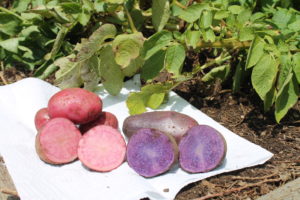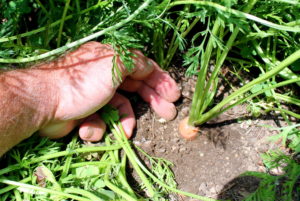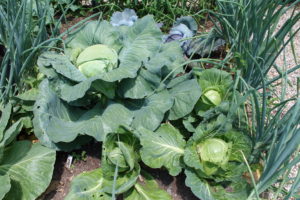Glorious Harvest (Mostly)
July 12th, 2016
This is the time of year when the vegetable garden is (or should be) coughing up plenty of goodies in return for our springtime work.

‘Adirondack’ potatoes have colorful flesh as well as colorful skin.
Although the cloudfest that was May set things back a bit this year, I’m enjoying an excellent bounty now.
The broccoli is down to side-shoot production, the lettuce has all been bagged (it just bolted last week), and I’ve been picking golfball-sized “new” potatoes for 2 weeks.
Shortly, I’ll be harvesting full-sized ‘Adirondack Blue’ and ‘Adirondack Red’ potatoes, which have purple and rose-colored flesh, respectively, and not just colored skins. The picking cue for me is when the foliage flops over and goes from green to yellow to brown.
I’ve never grown ‘Adirondacks,’ but they sounded like a good trick to get my 3-year-old granddaughter to eat potatoes other than french fries since I can refer to them as “big grapes” or “big cherries.”
I also got them free from my friend, Roger Springer, who brings big bags of seed potatoes into church every spring. Roger is general manager of the Pennsylvania Cooperative Potato Growers. (And no, I didn’t pick the church because I heard free seed potatoes were a bonus.)
Anyway, I’m also about ready to pull a block of carrots that I planted back around the end of March. I know these are ready by pulling dirt back from around the shoulders and gauging the size.
If I’m not sure, I’ll pull a carrot or two to see how they’re looking. I don’t like to wait too long, though, because 1.) “baby” carrots are the most tender, and 2.) the odds of maggot attack from the carrot rust fly go up the longer I let them in the ground.

Pull a little soil away from the carrot shoulders to gauge size.
That bug threat is true of a lot of veggies, which is why I lean toward fast-maturing varieties. The sooner I can get a crop in and out, the less chance a bug, animal, disease or hailstorm has of ruining it.
Another trick I use in the vegetable garden is staggering maturity and/or planting times.
Back when Sue and I canned and froze so many crops, the goal was to get a lot of stuff to ripen all at the same time. But now that our kids are grown and long gone from the nest, I’d rather harvest gradually over a longer period for fresh eating.
One way to do that is to buy two or three different varieties that mature at different times, then plant it all at once. If you have a quick-maturing bean, for example, as well as a mid-season version and a pole variety that takes longer to get going but produces on and on, then it’s possible to have fresh beans over a 2-month or longer period.

I’ve planted three different varieties of cabbage in this bed to stagger the harvest.
The other option is to buy all of one variety but plant every 2 or more weeks apart. You might like ‘Red Ace’ beets, for example, but instead of planting the whole pack at once, plant a third of the seeds in late April, a third in mid-May, and a third in early June (replacing a spring crop of radishes perhaps).
Some crops are more obvious to tell when they’re ready to pick than others.
Peppers, for example, are perfectly edible when small and green, but they’re really not fully mature until they turn color – red, gold, yellow, cream, brown or orange, depending on genetics.
Onions are edible at any stage, too, but they’re done growing when you see the swollen orbs at ground level and have leaves that are browning and flopping.
And tomatoes are ready when they go from immature green to red, pink, yellow or orange and have a soft feel to them. They’re sweetest when picked at peak, but you’ll get better shelf life out of heirloom types if you pick them at the beginning of coloring.
Despite the slow spring, by the way, I did manage to pick my first ripe tomato by the end of June. It was a single cherry tomato from a ‘Sweetie’ plant that I started from seed inside in early February and planted outside under a Wall o’ Water plant protector in late March.
On the other hand, it’s not always easy to tell when a melon is ripe. Some people do the “thump test” (a hollow sound means it’s ready), or they’ll look for a browning of the little “pig tails” at the blossom end, or they’ll go by color or the smell where the fruit attaches to the vine.
Corn is tricky, too. It sweetens quickly toward the end, but the kernels often look plump and ready before they’ve fully ripened. I use the fingernail test. Mature kernels will pop nicely when you puncture them, not squish (underdone) or feel hard and less “poppy” (overdone).
I put together a list of the 25 most common vegetables to help you know when is the ideal time to make your picking move. It’s posted under Edibles in my Storage Shed section.
The only thing that’s really fizzled for me so far this year was the Napa cabbage. I started this upright type with the ribbed leaves from seed, but it bolted to seed and was useless even before it hit pickable size. I’ve had decent success with Napas before, so I think it must’ve been the erratic weather.
The other harvest “challenge” has been with the blueberries. I have seven bushes that grow and produce nicely along my western property line. But if I don’t net them, the birds eat every last berry the day before peak ripeness.
Despite bird netting draped and secured over the whole planting, birds somehow are getting in, eating half my harvest and getting back out. Occasionally I find a hole they’ve pecked or a section where they’ve managed to push under. But most of the time, they seem to magically fly right through the netting.
This is why when people ask me for suggestions for the best bird-attracting plants for their yard, I mention blueberries first.
Next year, I’m getting much stronger netting. And maybe building a “blueberry house” frame-and-net structure.







